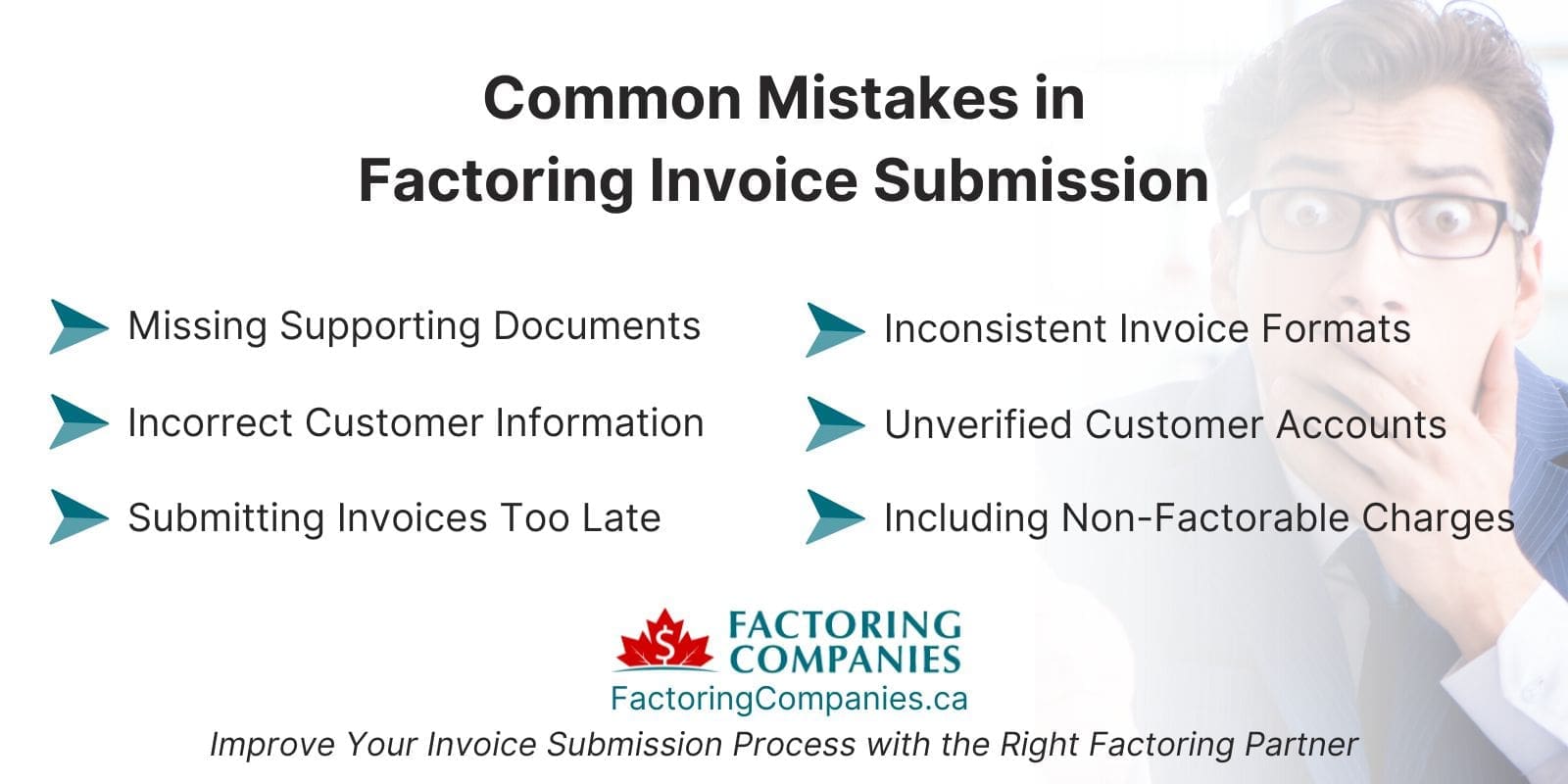
Factoring can put working capital in your hands on the same day you submit your invoice. However, the speed of your funding and whether or not an invoice gets a green light are tied to the quality of the documentation you provide. On this page, we’ll explore how to optimize invoice submission for factoring approvals, so you can breeze through the process and get paid quickly.
The Factoring Process: A Quick Overview
When you partner with a factoring company, you’re essentially trading in your unpaid invoices for immediate working capital. It’s a way to smooth out your cash flow without taking on debt, and it all starts before you even think about invoice submission.
How the Full Factoring Process Works
- Factoring Application and Business Approval: First, your business goes through a short application process. Getting approved for factoring is simple and can often be completed in under one business day, especially if your records are well organized.
- Customer Approval: Once you’re approved, your customers are evaluated. This is one of the biggest benefits of factoring: approval is based on your customers’ creditworthiness, not yours. That means your ability to factor depends on how reliable your customers are when it comes to paying their invoices.
- Invoice Submission and Verification: This is where your invoice submission process becomes critical. Each invoice you submit is reviewed before you receive funding. Invoices that are missing documentation, have errors, or don’t align with the factoring company’s guidelines can delay your advance or even be rejected. So what you do here affects everything downstream.
- Receiving the Advance: Once the invoice is approved, most factoring companies will advance you between 80 and 95 percent of the invoice total. Funds are usually deposited within one or two business days, but sometimes even faster.
- Collections and Final Payment: The factoring company then collects payment directly from your customer. Once the customer pays, you’ll receive the remaining amount of the invoice, minus the factoring fee.
Factoring Approvals Explained
Once you’re approved as a client, the next step is getting your invoices approved. This part of the factoring process for invoice approval often moves quickly if the right groundwork is in place.
Steps for Factoring Invoice Approvals
Every factoring company is a little different, but most follow a similar review process. Understanding these steps helps you avoid delays and gives you more control over when and how you get paid.
- Client Setup is Confirmed: Before anything can be approved, your factoring agreement must be active. This includes setting up your account, linking your bank details, and agreeing to terms.
- Customer Credit is Verified: The factoring company reviews your customer’s credit standing. Even if you’ve done business with them for years, your factor needs to assess their ability to pay. This is often a one-time approval per customer but may be revisited over time.
- Invoice Details Are Matched to Agreement Terms: Once your customer is approved, individual invoices are reviewed for alignment with your contract. For example, some factoring companies only accept invoices for completed work or delivered goods, and many require invoices to be issued within a certain time frame.
- Documents Are Reviewed Against the Checklist: Your invoice and supporting documents must match what’s listed in the factoring approval document checklist. This checklist varies by provider but often includes things like proof of delivery, signed time sheets, or purchase orders.
- Approval is Issued or Delayed: If everything is in place, the invoice is approved and moved forward for funding. If something’s missing or inconsistent, your team will be contacted to clarify.
Causes of Approval Delays
Most delays come down to missing or mismatched paperwork. Even something as small as an incorrect customer name or an outdated purchase order can trigger a manual review.
That’s why it helps to build your own invoice factoring checklist based on your provider’s requirements, and to treat accurate documentation for factoring approval as part of your internal workflow.
Organizing Your Documents Before You Submit
You don’t have to wait until the submission stage to get organized. In fact, most businesses save time by working ahead. That means addressing the areas outlined below.
- Invoice Preparation for Factoring: Double-checking that each invoice includes the details your factor expects, before it’s sent or partnering with a factoring company that provides invoice preparation services.
- Organizing Documents for Factoring Submission: Creating internal folders or systems that group invoices with their related documents. That way, your team can respond quickly if questions come up.
Typical Factoring Company Invoice Guidelines
After your account is active and your customers are approved, factoring companies apply a standard set of rules to evaluate the invoices you submit. These factoring submission guidelines help ensure that every invoice is valid, collectible, and eligible for funding under your agreement.
While the exact requirements vary from one provider to another, most follow a similar pattern.
Common Invoice Factoring Document Requirements
- Customer Must Be Approved: The customer listed on the invoice must have already gone through the factoring company’s credit review process and received approval.
- Invoice Must Reflect Completed Work or Delivered Goods: Most factoring companies will not fund invoices for work that has not been completed or goods that have not been delivered.
- Invoice Must Be Dated and Numbered Clearly: Each invoice should have a unique identifier and a date. This helps prevent duplicates and makes it easier to track payments.
- Invoice Must Include the Correct Business Name: The business name on the invoice should match the name registered with your factoring company. If you operate under multiple names, this should be addressed during setup.
- Invoice Terms Must Match Agreement: The payment terms listed, such as net 30 or net 60, must match what was agreed to with the customer and what your factoring company expects.
- Supporting Documents Must Be Attached if Required: Many providers ask for documents such as signed delivery receipts, proof of service, or purchase orders. These expectations are part of the invoice factoring document requirements outlined in your agreement.
- Invoice Must Be Submitted Within Time Limits: Factoring companies often have time limits on how old an invoice can be when submitted. Invoices that are too old may be rejected.
How to Submit Invoices for Factoring
Once your customer and invoice are both eligible, the next step is submitting it for approval. The invoice submission method varies depending on your factoring company, but most follow a predictable system. Getting familiar with it helps ensure smoother processing and faster access to funds.
Common Submission Methods
- Client Portal Uploads: Many factoring companies offer an online portal where you can log in, upload your invoice, and attach supporting documents.
- Email Submissions: Some providers accept invoices by email. They may ask you to include specific information in the subject line or attach documents in a certain order.
- Software Integrations: A few factoring companies allow you to submit invoices directly through accounting platforms like QuickBooks or Xero. This option reduces manual work but typically requires an initial setup.
Common Mistakes in Factoring Invoice Submission
Even small missteps in your invoice submission process can slow down approvals or trigger unnecessary follow-ups. The good news is that most of these issues are easy to spot and even easier to fix once you know what to look for.

Frequent Issues That Cause Delays
- Missing Supporting Documents: Failing to attach required documents like signed delivery receipts or proof of service is one of the most common reasons an invoice gets flagged.
- Incorrect Customer Information: Using a business name that doesn’t match the factoring company’s records can lead to delays or rejection. This is especially common when businesses operate under multiple names or trade names.
- Submitting Invoices Too Late: Many factoring companies have time limits for how long after the work is completed an invoice can be submitted. Submitting outside of that window often requires additional approvals or may result in denial.
- Inconsistent Invoice Formats: Changes to the layout, numbering system, or required details can confuse automated systems and delay processing.
- Unverified Customer Accounts: Submitting invoices for customers who haven’t yet been approved by the factoring company will hold everything up until the customer review process is complete.
- Including Non-Factorable Charges: Adding items like future work, deposits, or unrelated fees can raise red flags. Most companies only accept invoices tied to completed work or delivered goods.
Additional Factoring Invoice Submission Tips
Improving your invoice submission process does not require a full system overhaul. Small changes can lead to faster approvals, fewer errors, and less time spent following up with your factoring company.
Proven Ways to Streamline the Process
- Verifying Invoice Details Before Submission: Take a moment to double-check each invoice. Look for typos, incorrect dates, missing line items, or mismatched customer information. Small errors create delays that are easily avoided.
- Creating an Internal Submission Checklist: Use a standard template or process to ensure each invoice includes the right supporting documents. This keeps your team aligned and helps reduce back-and-forth.
- Using Digital Tools Improving Factoring Efficiency: Many businesses use cloud-based tools to manage invoice records, organize backup documentation, and share files securely with their factoring provider. These platforms reduce the time spent tracking files manually.
- Automating Invoice Tracking for Faster Feedback: Setting up automatic tracking systems, whether through accounting software, your client portal, or even a shared spreadsheet, makes it easier to monitor which invoices are pending, approved, or funded. Some factoring companies also offer real-time status updates through their portals.
- Assigning a Dedicated Point Person: Having one team member oversee invoice submission keeps your process consistent and allows that person to build a working relationship with your factoring provider.
Improve Your Invoice Submission Process with the Right Factoring Partner
Even the best internal processes rely on the right external support. We can match you with factoring companies known for fast, reliable approvals and clear submission guidelines that make getting paid easier. To take the next step, request a complimentary rate quote.
FAQs on Invoice Submission for Factoring Approvals
How do I know if an invoice is eligible for factoring approval?
An invoice is typically eligible if it’s for completed work or delivered goods, tied to an approved customer, and submitted within the allowed timeframe. Your factoring agreement will outline exact conditions for eligibility, including any restrictions on invoice age or type.
What’s the fastest way to submit invoices for factoring approval?
Using a client portal or integrated accounting software is often the fastest way to submit invoices. These systems allow for organized uploads and instant tracking, which reduces back-and-forth and helps speed up the approval process.
How long does invoice approval take after submission to a factoring company?
Most factoring companies review and approve invoices within one business day, provided the documents are complete and accurate. Delays can occur if something is missing or doesn’t match your agreement, so consistency is key.
What causes delays in invoice approval for factoring?
Delays often stem from missing documents, incorrect customer names, inconsistent invoice formatting, or submitting invoices for unapproved customers. Verifying all details before submission and using a standard process helps reduce issues.
Can I submit invoices for unapproved customers to my factoring company?
No. Most factoring companies require that each customer be approved before you submit invoices tied to them. If a customer has not been reviewed, the invoice will likely be held or rejected until that step is completed.
Do all factoring companies require supporting documents with each invoice?
Not all, but most do. The types of documents required depend on your industry and agreement. Common examples include signed time sheets, bills of lading, or purchase orders. These help verify that the invoice reflects completed, billable work.
How can I improve my invoice submission process to get faster approvals?
Use a consistent checklist, verify invoice details before submission, and organize documents clearly. Digital tools can also help by streamlining your uploads and automating tracking. These small steps often lead to faster approvals and fewer interruptions.

About Factoring Companies Canada
Related Articles
Get an instant factoring estimate
Factoring results estimation is based on the total dollar value of your invoices.
The actual rates may differ.
CLAIM YOUR FREE FACTORING QUOTE TODAY!
PREFER TO TALK?
You can reach us at
1-866-477-1778
Get an instant factoring estimate
Factoring results estimation is based on the total dollar value of your invoices.
The actual rates may differ.
CLAIM YOUR FREE FACTORING QUOTE TODAY!
PREFER TO TALK? You can reach us at 1-866-477-1778











